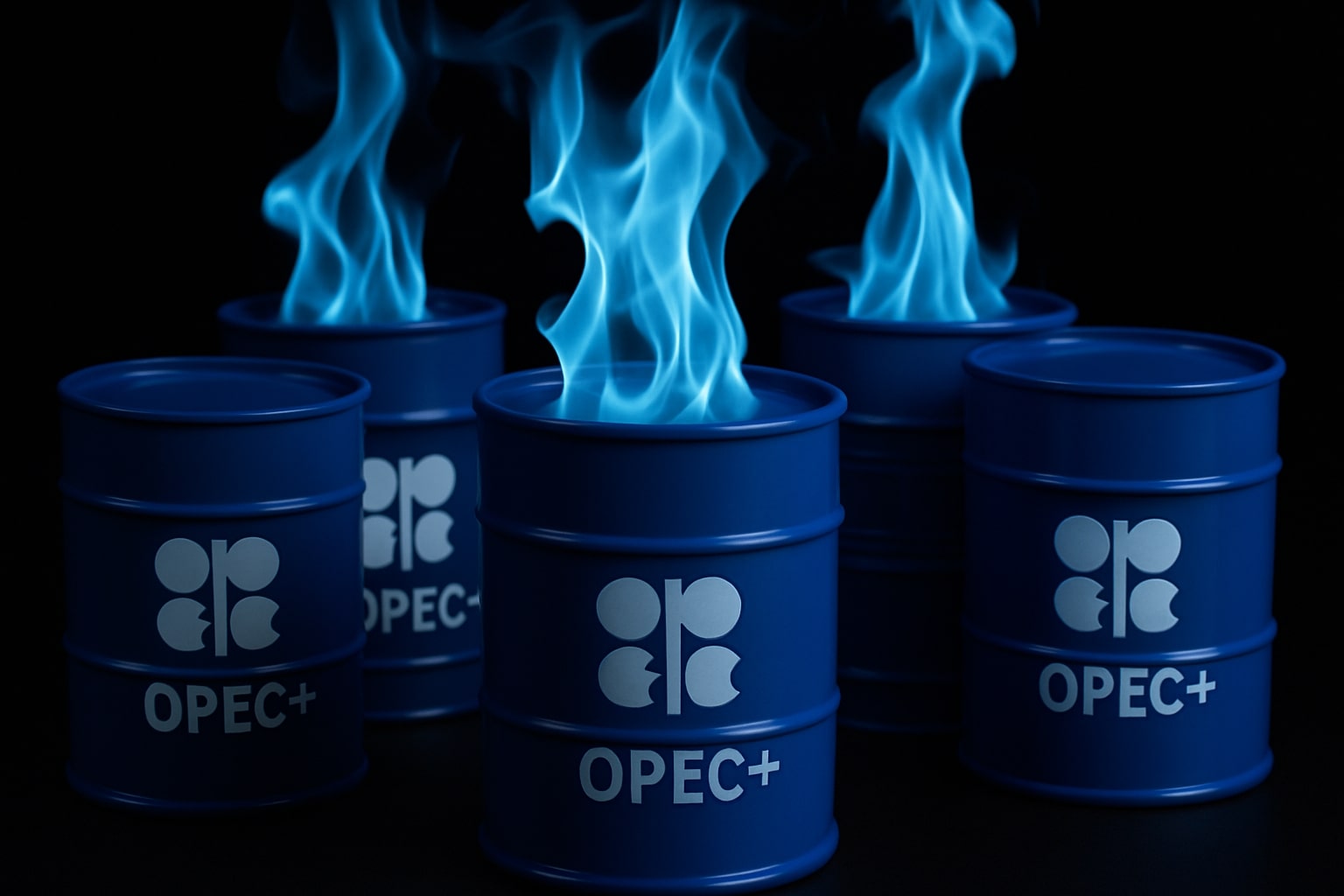
Oil Price Forecast - Oil Prices Steady at $58 WTI, $63 Brent as Peace Talks and Fed Rate Bets Battle Oversupply
Crude markets hold in a narrow range with WTI (CL=F) at $58.46 and Brent (BZ=F) at $62.92, balancing optimism over potential Fed easing against fears of Russian oil returning to market | That's TradingNEWS
Crude Oil (CL=F, BZ=F) Holds Near $58–$63 as Peace Hopes, Fed Rate Bets, and Oversupply Collide
WTI and Brent Rebound Slightly but Stay Deep in Bear Territory
West Texas Intermediate (CL=F) traded around $58.46 (+0.69%), while Brent (BZ=F) hovered at $62.92 (+0.58%), after hitting their lowest levels since October 21. Despite the minor uptick, both benchmarks remain down roughly 14% year-to-date as supply gluts and a stronger dollar overwhelm intermittent rallies. Murban crude climbed 0.67% to $64.52, Louisiana Light slipped 0.38% to $62.27, and Bonny Light plunged 2.84% to $78.62. The OPEC basket stood at $63.00, off 2.39%, underscoring that price weakness is broad-based, not regional.
Markets React to Two Conflicting Forces — Fed Easing vs. Ukraine Peace Progress
Investors are weighing the bullish prospect of a U.S. Fed rate cut against bearish momentum from Ukraine-Russia peace talks that could reopen Russian exports. The U.S. and Ukraine met in Geneva, describing negotiations as “highly productive,” with European Council President Antonio Costa pledging continued EU backing for Kyiv. Any durable accord could prompt sanctions relief on Rosneft (ROSN.MM) and Lukoil (LKOH.MM)—a scenario that would add roughly 1.8 million bpd back into global supply within months, according to Onyx Capital estimates.
Oversupply Intensifies as Global Production Outpaces Demand
Goldman Sachs projects a 2 million bpd surplus through 2026, calling for WTI to average $53 and Brent $58 next year. J.P. Morgan expects a deeper slide by 2027, targeting $57 Brent and $53 WTI, warning that inventories could push Brent briefly into the high $30s before rebalance in 2028. OPEC + output, combined with record non-OPEC flows from the U.S., Brazil, and Guyana, continues to drown price rallies. The U.S. rig count ticked up modestly, while Saudi crude exports hit a seven-month high, confirming producers remain unwilling to curtail.
Macroeconomic Pressures: Dollar Strength and Rate Divergence
The dollar index (DXY) touched its highest since May, magnifying dollar-denominated price drag. Fed Governor Christopher Waller stated that labor data justify another 25-basis-point cut, but traders remain split on December action. Lower rates could stimulate energy demand, yet near-term fundamentals—especially bloated inventories—dominate sentiment.
Technical Structure: WTI Trapped Below $60, Brent Capped at $65
WTI futures oscillate tightly around $58, having filled the October sanctions gap. Resistance forms at the 50-day EMA near $60.20, followed by $62.50. A daily close beneath $57.80 exposes $55.40 and $53.00. Brent faces dual resistance at $65.00 and its 50-day EMA, with downside support at $60.00. Analysts describe every failed rally as a new shorting window.
Geopolitical Layer: Russia’s Fiscal Squeeze and Sanction Dynamics
Russia’s state oil-and-gas revenue is projected to fall 35% y/y to 520 billion roubles (~$6.6 billion) this month, hit by softer prices and a firmer rouble. However, easing sanctions could reverse that trajectory rapidly. The Oil Price Cap (OPC) mechanism—once intended to strangle Moscow’s receipts—is now widely deemed obsolete. Approximately 13% of the global tanker fleet operates under shadow ownership to circumvent Western tracking. The U.S. Treasury’s new designations of Lukoil and Rosneft mark a shift toward comprehensive bans, forcing Indian Oil Corp, BPCL, HPCL, and Reliance to reconsider Russian supply contracts. Chinese majors PetroChina, Sinopec, and CNOOC have begun diversifying cargoes to Middle Eastern blends.
Supertanker Rates and Freight Markets Show Stress
Freight costs have exploded as Asia races to replace Russian barrels. VLCC rates on the Middle East–China route climbed above WS 90, the highest in over two years. This surge highlights a tightening logistics chain despite ample crude supply—an unusual divergence signaling that physical trade is pivoting, not shrinking.
Demand Outlook: Slowing Economies and Structural Headwinds
Europe’s IFO Business Climate Index dropped to 88.1, and Germany’s manufacturing PMI slid to 48.4, confirming stagnation in core consumption hubs. China’s crude imports rose 11% y/y, but most barrels feed state stockpiles, not end-user demand. The IEA warned of a 2026 glut unless producers curb output by at least 1.3 million bpd. Global demand is forecast at 103.6 million bpd for 2025, up just 0.9%, the slowest expansion since 2020.
Energy Policy and Market Intervention Risks
Washington’s shifting stance—oscillating between sanction escalation and domestic drilling incentives—adds volatility. President Trump’s new plan to expand California offshore drilling clashes with state opposition but could lift U.S. output another 300 kbpd by 2026. Meanwhile, EU policymakers debate scrapping the price-cap regime altogether, replacing it with a blanket services ban for Russian oil. If enacted, Brent could spike $5–$7 per barrel short-term due to logistical realignment.
Technical Sentiment and Trader Positioning
Managed-money net-longs on WTI futures fell 12% week-on-week, reaching their lowest since August. Open interest across ICE Brent declined 9%, underscoring fading speculative participation. The short-to-long ratio now sits near 1.6:1, showing market bias remains bearish. RSI readings for both contracts hover around 38–42, confirming mild oversold but not capitulated conditions.
Forward Curve and Inventory Trends
Both benchmarks remain in contango—front-month discounts widened to $0.65 Brent and $0.72 WTI, signaling excess supply. U.S. EIA data show commercial crude stocks at 448.2 million barrels, up 5.4 million week-on-week. Gasoline prices eased 0.10% to $1.882 per gallon, while natural gas (NG=F) slid 1.75% to $4.50 per MMBtu.
Outlook Through 2027: Rebalance After the Glut
Both Goldman Sachs and J.P. Morgan expect supply moderation only after 2026. The final oversupply wave will come from new OPEC + and Latin-American projects, after which depletion rates and capex restraint should tighten balances. Brent is forecast to stabilize around $57 in 2027, before recovering toward $70 by 2028 if investment cuts persist.
Read More
-
NVIDIA Stock Price Forecast - NVDA Shares Posts $57B Quarter as AI Boom Fuels $500B in Future Orders
24.11.2025 · TradingNEWS ArchiveStocks
-
XRP Price Forecast - XRP-USD Steadies Above $2.00 as XRP ETF Inflows Surge and Binance Liquidity Shrinks
24.11.2025 · TradingNEWS ArchiveCrypto
-
Gold Price Forecast - Gold Hovers at $4,055 as Strong Dollar Caps Gains — BofA Eyes $5,000 in 2026 on Global Supply Crunch
24.11.2025 · TradingNEWS ArchiveCommodities
-
Stock Market Today - Nasdaq Jumps 2.07% as Alphabet and Tesla Spark AI Revival — Fed Cut Odds Top 75%
24.11.2025 · TradingNEWS ArchiveMarkets
-
GBP/USD Price Forecast - Pound Steadies at 1.3088 as UK Budget Looms and BoE Cut Bets Rise to 70%
24.11.2025 · TradingNEWS ArchiveForex
Strategic Assessment
Oil’s structural weakness is now driven by relentless supply, easing risk premiums, and eroding demand growth. The market no longer trades on geopolitics alone; it is pricing a full re-normalization cycle post-Ukraine war. Unless OPEC + acts aggressively or a major supply disruption emerges, rallies are likely capped at $65 Brent / $60 WTI.
Verdict: Sell (Short-Term Bearish Bias)
The data confirm persistent oversupply and demand fatigue. WTI (CL=F) faces resistance at $60, Brent (BZ=F) capped near $65. A return to $55 WTI and $57 Brent remains the most probable path before equilibrium in 2027. Only decisive OPEC + restraint or sustained Fed easing could reverse this trajectory.



















